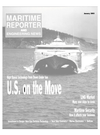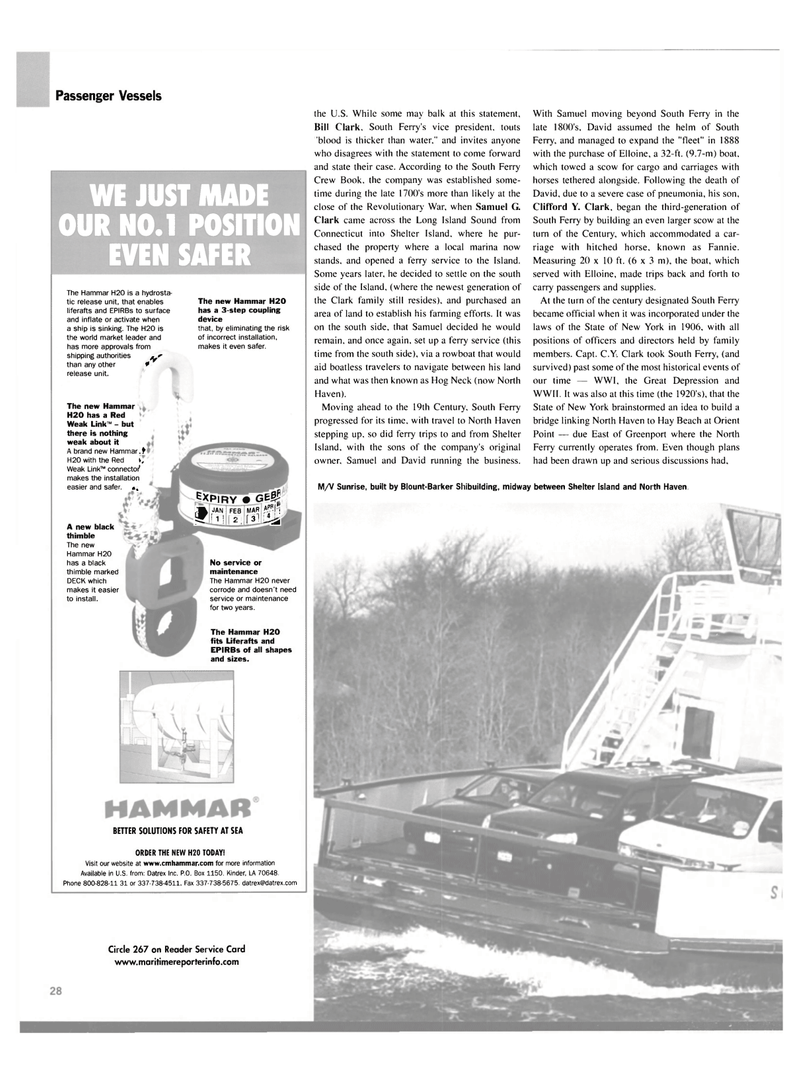
Page 28: of Maritime Reporter Magazine (January 2003)
Read this page in Pdf, Flash or Html5 edition of January 2003 Maritime Reporter Magazine
Passenger Vessels
WE JUST MADE
OUR NO.l POSITION
EVEN SAFER
The new Hammar
H20 has a Red
Weak Link - but there is nothing weak about it
A brand new Hammar A
H20 with the Red t.
Weak Link™ connectoi* makes the installation easier and safer. »,
Moving ahead to the 19th Century. South Ferry progressed for its time, with travel to North Haven stepping up. so did ferry trips to and from Shelter
Island, with the sons of the company's original owner. Samuel and David running the business.
State of New York brainstormed an idea to build a bridge linking North Haven to Hay Beach at Orient
Point — due East of Greenport where the North
Ferry currently operates from. Even though plans had been drawn up and serious discussions had.
M/V Sunrise, built by Blount-Barker Shibuilding, midway between Shelter Island and North Haven tXPlRv • Gtyj m JAN I FEB I MAR fj ^ETl ran [jliljtja
A new black thimble
The new
Hammar H20 has a black thimble marked
DECK which makes it easier to install.
No service or maintenance
The Hammar H20 never corrode and doesn't need service or maintenance for two years.
The Hammar H20 fits Liferafts and
EPIRBs of all shapes and sizes.
BETTER SOLUTIONS FOR SAFETY AT SEA
ORDER THE NEW H20 TODAY!
Visit our website at www.cmhammar.com for more information
Available in U.S. from: Datrex Inc. P.O. Box 1150. Kinder, LA 70648.
Phone 800-828-11 31 or 337-738-4511. Fax 337-738-5675. [email protected]
Circle 267 on Reader Service Card www.maritimereporterinfo.com
The Hammar H20 is a hydrosta- tic release unit, that enables liferafts and EPIRBs to surface and inflate or activate when a ship is sinking. The H20 is the world market leader and has more approvals from shipping authorities ^ than any other * release unit.
The new Hammar H20 has a 3-step coupling device that, by eliminating the risk of incorrect installation, makes it even safer. the U.S. While some may balk at this statement,
Bill Clark. South Ferry's vice president, touts "blood is thicker than water," and invites anyone who disagrees with the statement to come forward and state their case. According to the South Ferry
Crew Book, the company was established some- time during the late 1700's more than likely at the close of the Revolutionary War, when Samuel G.
Clark came across the Long Island Sound from
Connecticut into Shelter Island, where he pur- chased the property where a local marina now stands, and opened a ferry service to the Island.
Some years later, he decided to settle on the south side of the Island, (where the newest generation of the Clark family still resides), and purchased an area of land to establish his farming efforts. It was on the south side, that Samuel decided he would remain, and once again, set up a ferry service (this time from the south side), via a rowboat that would aid boatless travelers to navigate between his land and what was then known as Hog Neck (now North
Haven).
With Samuel moving beyond South Ferry in the late 1800's, David assumed the helm of South
Ferry, and managed to expand the "fleet" in 1888 with the purchase of Elloine, a 32-ft. (9.7-m) boat, which towed a scow for cargo and carriages with horses tethered alongside. Following the death of
David, due to a severe case of pneumonia, his son,
Clifford Y. Clark, began the third-generation of
South Ferry by building an even larger scow at the turn of the Century, which accommodated a car- riage with hitched horse, known as Fannie.
Measuring 20 x 10 ft. (6 x 3 m), the boat, which served with Elloine, made trips back and forth to carry passengers and supplies.
At the turn of the century designated South Ferry became official when it was incorporated under the laws of the State of New York in 1906, with all positions of officers and directors held by family members. Capt. C.Y. Clark took South Ferry, (and survived) past some of the most historical events of our time — WWI, the Great Depression and
WWII. It was also at this time (the 1920's), that the

 27
27

 29
29
